Dobrý článek. Díky za něj. Slušelo by mu místo v časáku LH.
One forgotten anniversary, 500 years since the death of Vladislav II. Jagiellonian Monarch
Categories: Minting - Numismatics
Somewhat in the shadow of the ongoing celebrations of the 700th anniversary of the birth of the Czech King and Holy Roman Emperor Charles IV. In March, we marked the 500th anniversary of the death of King Vladislav II of Bohemia and Hungary. Jagiellon and the accession of his son Louis to the Czech and Hungarian throne. The Jagiellonian dynasty reigned in the lands of the Bohemian Crown for 55 years and left an indelible mark on Czech government coinage. Apart from the coins themselves, we have preserved rich written sources from this period. Among them, we can include in particular the Kutná Hora mint accounts, the so-called registers of verk, which were drawn up at regular weekly intervals by an authorised official of the Kutná Hora mint. They inform us not only about all standard and extraordinary issues from the treasury (e.g. but also indirectly about the progress of the mint's production and the type and number of coins struck.
The preserved register from the reign of Vladislav II. Jagiellonian dynasty begin in 1472 and document the minting of Prague groschen not long after his accession. This was due to the revival of mining in Kutná Hora under the previous reign after several decades of decline.King Jiří of Poděbrady and the resumption of Prague groschen minting following the coinage reform of 1469. Only a few surviving pieces of groschen with the name of Ladislaus I are known today. (The reason for the limited number of pieces minted was most probably only for representational purposes, and their minting during the reign of King George of Poděbrady cannot be ruled out. During the reign of Vladislav, a huge number of Prague groschen came out of the Kutná Hora mint, the verka register records show, for example, almost 3 million pieces minted in 1473 and more than 2.6 million in 1504. A significant decline in silver production occurred in the last years of the reign, and Prague grosz from this period are among the rarest. As regards the quality of Vladislav's coins, information is mainly found in extant written sources. In the early period of the reign, nine-lot grosz of 562/1000 purity were minted in accordance with the coinage regulations of 1469. However, the Ag content was gradually reduced, to 8 lots (purity 500/1000) in 1483, and from 1486 until the end of the reign, seven-lot Prague grosz of purity 437/1000 left the mint.
During the long reign of Vladislav II. During the long reign of Vladislav II of Jagiellon, the overall imagery of the Prague grosz, namely the representation of the lion, the crown, the script and the division marks, also evolved. This transformation takes place depending on the minting period associated with the person of the mintmark cutter. The most significant change takes place at the very end of Vladislav's reign, when the original Gothic image of the lion with a maneThe original lion with a lion's crest composed of several rows of crescents is replaced by a new representation in the spirit of the emerging Renaissance style. Along with the new image of the lion, we find on the reverse side of the coin a description made for the first time in Renaissance majuscule. The typological treatment of the Prague groschen of Vladislav II. Jagiellonian princes were dealt with in detail by J.Hásková.

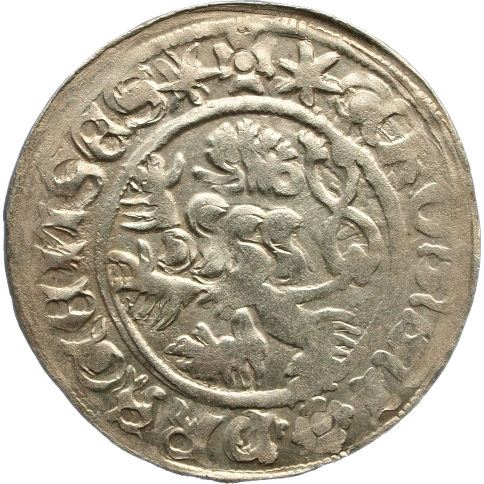
Prague groschen with the so-called Gothic lion
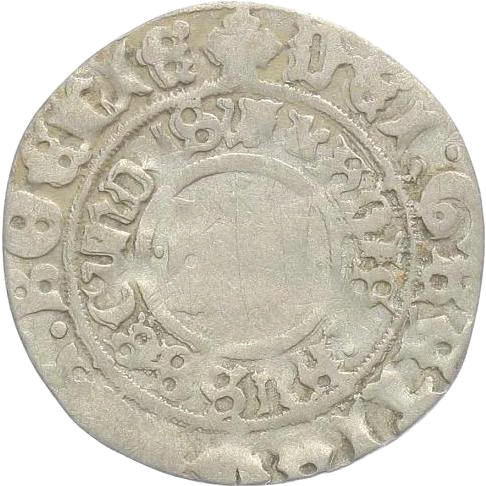

Prague groschen with the so-called Renaissance lion
In the early period of the reign of Vladislav II. Jagiellonian period, only Prague grosz were minted in the mint in Kutná Hora. However, the small coins minted during the reign of George of Poděbrady began to gradually decline in circulation, which necessitated the minting of a new type of penny in March 1482. This denomination, with a prescribed content of Ag 187/1000 and also called the small or black penny, had a payment It was minted at irregular intervals and of unchanged purity until the end of Vladislav's reign. It was sometimes referred to as black because of its dark colour due to its low silver content and the fact that during the production process the casing was no longer bleached before minting. The single-sided penny features the crowned initial of the king's name, according to its design we can distinguish several pictorial variants today.
The second small denomination was a white penny, referred to as a denarius in contemporary written sources. The first minting of this 1/7th of a Prague penny took place on 10 March 1483, the purity of Ag was set at 437/1000. The silver content was reduced to 6 lots (purity 375/1000) in 1485 and did not change any further. The white penny was initially minted as a double-sided coin, with the image of the Bohemian lion on the obverse and a copy of the king's name on the reverse with the crowned initial W. With the reduction of the Ag content in 1485, the design was also changed; from then on it was minted as a single-sided coin. An exception is the double-sided mintage of 1498, when it was resumed after a hiatus of about 11 years. After 1498, however, white money continued to be struck only as one-sided money. Similarly to the Prague groschen, the white money gradually changed the design of the Bohemian lion and the font. For example, the coins minted before 1487 and after the restoration of the coinage in 1498 can be easily distinguished by the design of the lion's tail, with the open end at the top being the older coinage, while the younger ones have the lion's tail closed at the top. The typology of white money from the Jagiellonian period was studied in detail in the 1930s by K.Castelin, his conclusions for Vladislav's coins were refined and supplemented a few years ago by V. Brádle when processing the discovery of coins from Radec.




The pennyDouble-sided white pennySingle-sided white penny
During the reign of Vladislav II. Jagiellonian dynasty, the minting of Czech ducats resumed after many decades. The last time they were minted was during the reign of Wenceslas IV in the 1490s. The minting of gold coins was traditionally carried out in Prague under the supervision of the king and the supreme mintmaster since the time of John of Luxembourg. Unlike the Hungarian gold coins that also circulated in Jagiellonian Bohemia, Czech ducats were minted only in very limited numbers due to the scarcity of gold. The mines in Jílové and Knín were mainly involved in the supply of the yellow metal to the Prague mint. On the obverse side of Vladislav's ducats we can find a Czech lion in a shield under the initial W, on the reverse side there is a standing Prince St. Wenceslas in full armour. The pictorial part is complemented by a copy with the name of the king or St. Wenceslas around the perimeter, and in the case of a single type also the year. Of the several pictorial and descriptive variants of Czech ducats of Vladislav II. The type with the year 1511 is particularly interesting; it is the first ever Czech dated coin.


Ducat without date


Dukát 1511
The Kutnohorská registry also mentions the occasional minting of some atypical denominations. The so-called thick grosz and thick money of the same purity as the standard coins were minted on much thicker and thus more massive dies. The careful design of these exceptional coins, intended exclusively for the personal use of the king and the highestthe King and the Master of the Mint shows that they were used for the endowment of distinguished persons associated with the presentation of the wealth of the Kutná Hora mines.
In addition to the government mints in Kutná Hora and Prague, the municipal mint in Kutná Hora was in operation during the last years of Vladislav's reign.Cheb, producing non-government coins on the basis of an older mint privilege confirmed by Vladislav II. It minted coins with the municipal emblem on the obverse and the Gothic letter E on the reverse (abbreviation of the German name of Eger).
On 13 March 1516, King Vladislav died in Buda and his son Ludvík Jagellonský took over the government of the Bohemian Crown. Ludvík was crowned King of Bohemia in 1509, during his father's lifetime, and this event is commemorated by a Prague coin bearing the names of both monarchs on its face. On this occasion Vladislav II. Jagiellonian, on behalf of his minor son, made a promise not to debase the government coinage in the future, which Louis kept throughout his reign.
As we are informed by the registers, during Ludwig's reign mainly small denominations were minted, namely pennies and white money. On the pennies of Louis of Jagiellon, the letters R and P (abbreviation Rex Lvdovicvs Primvs) complete the crowned initial L on the sides. In addition to these single-sided issues, we also know of a rare double-sided penny with a Bohemian lion on the reverse. On its obverse we find one double concentric ring instead of the letters R and P. Similarly to Vladislav's mintages, among Ludvík's pennies we can distinguish a number of variations in the design of the initial and the royal crown and, depending on the position of the letters on the sides of the initial, also several misprints. A detailed typology of these mintages was prepared and recently published by P. Gregor.
Louis's one-sided white money retains the appearance of Vladislav's mintages from the last period of his reign. Apart from the change in the design of the copy by introducing the name of the new king, we also note the expansion
of the number of variants in the used division signs. Also in the case of the Bohemian lion we find differences in the representation of its body and hind legs.



One-sided pennyDouble-sided penny

White penny one-sided
Only in two weeks during Ludvík's reign are Prague grosz also minted at the Kutná Hora mint, in December 1523 and February 1524. However, no complete register has survived for 1524, and some indications point to one more week associated with the minting of grosz in that year. Due to the continuing problems with silver mining, the volume of Prague groschen minted in comparison with them of Vladislav's reign was absolutely minimal; according to written records, only about 60,000 pieces were minted between December 1523 and mid-March 1524. After the grosz of Ladislav the Terrible, Ludvík's Prague grosz are among the rarest today. We can find on them a Bohemian lion of the Gothic or Renaissance type known already from the groschen of Vladislav II. A new type is the Renaissance lion with rich decorations found especially on the undated Prague grosz of Ferdinand I.This appearance of the same type of lion on the coins of several rulers is connected with anotherm use of unworn reverse dies in the minting of the groats of the next ruler. The obverse stamps had to be made new with the reign of another king, and so it is not surprising that there was a significant change in the depiction of the royal crown. It always retains a uniform appearance on the Kutná Hora grosz of Ludvík Jagellonský, irrespective of the typeface used in the descriptions. Thanks to the various combinations of face and reverse dies, we know Ludwig's coins not only withGothic or Renaissance typeface on both sides, but also with one typeface on the obverse and another on the reverse. According to the available information, a new typological analysis of Prague groschen fromthe reign of Louis Jagiellon, replacing the previously used elaboration by J.Hásková.
Written sources in the form of the memoirs of Mikuláš Dačický of Heslov mention the handing over of a large number of fat groschen to King Ludvík Jagellonský and his wife Queen Maria of Habsburg during a visit to Kutná Hora in 1522. If there was indeed a minting of fat groschen with Ludvík's name in Kutná Hora, not a single surviving piece is currently known.
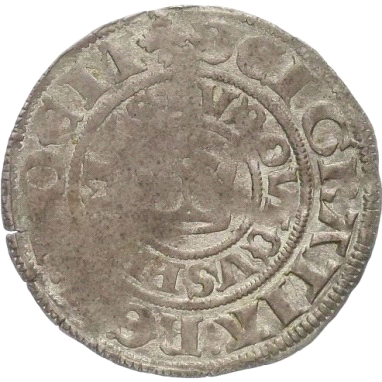

Prague groschen with the so-called Gothic lion


Prague groschen with the so-called Gothic lion. Renaissance lion
After the restoration of Czech ducats by Vladislav II. Jagiellonian rule, their very limited production continued at the Prague mint even during the reign of Ludvík. Pictorially, they retain the character of Vladislav's coins, the Bohemian lion being placed in the shield or freely inside the inner pearl. Above the lion there is a crowned initial L, possibly M or W. The side with the lion on the right is complemented under the saint's feet by the coat of arms of the supreme mintmaster Vilém Kostka of Postupice or Jindřich Tunkel of Brníček. Ludvík's Czech ducats are known both undated and with the years 1518 and 1521.
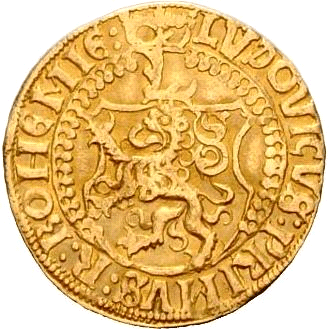

Dukát without a year
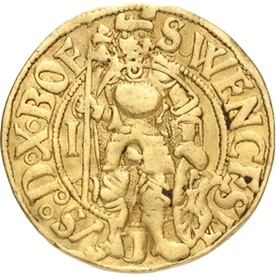
Ducat 1518
During the reign of Louis Jagiellonian, a significant event that influenced Czech coinage for the next 150 years. On the Bohemian side of the Ore Mountains, in the vicinity of today's town of Jáchymov, rich deposits of silver ore were discovered. It happened on land belonging to the property of the Šlik family of Pasoun. Since the export of unwrought silver had been forbidden since the monetary reform of Wenceslas II, the Šlik family looked for a way to make the best legal use of the acquired wealth. Negotiations with the then highest representatives of the nobility, Zdeněk Lv of Rožmitá, proved to be the right choice.Lu, Ladislav of Šternberk and Jan Pluh of Rabštejn and the subsequent contractual arrangement with them for the payment of a certain share of the profits. In return, these leaders pushed the Provincial Assembly to approve the resolution of 9. On January 1520, the Council of Rabbinical Council adopted a resolution on January 1520, which allowed the Šlik family to mint their own coins on the condition that "the rights and freedoms of the land are not harmed". Incidentally, this provision was later skilfully used by Ferdinand I to take over the Šlik mint in the hands of the Czech king in 1528. The resolution also set out the form and parameters of the Šlik coins. It also determined that two-thirds of the silver obtained would be used for the minting of large coins worth the Rhine gold piece and its parts (1/2 and 1/4), the remainingThe remaining third was to be used for the obligatory minting of Prague grosz differing from the Kutná Hora grosz only by the insertion of the Šlikov coat of arms in the description. The Assembly resolution was still subject to the approval of King Ludwig Jagiellon, which was allHowever, it has not survived in written form and today the prevailing opinion is that the minting of Šliky coins was only tolerated by him. Since the preparatory work had been carried out in secret since 1519, the minting of Šlik coins in Jáchymov could have started in full swing immediately after the approval of the Provincial Assembly.
During the reign of Ludwig, the Šlik family minted mainly large silver coins calledJoachimsthaler Guldengrosch, later abbreviated to Thaler (thaler), and intended mainly for the market in neighbouring Saxony. Unfortunately, due to their high purity, Shlik coins were later widely recast into low-quality foreign coinage. On the other hand, the circulation of Prague groschen was not allowed in Saxony and so their minting was not supported despite the request of the Schlika Provincial Assembly. Although no written sources documenting the quantity of groschen minted in Jáchymov have survived, it is safe to assumeIt can be safely assumed that the provision for their minting in the amount of one third of the mined silver was not observed. This is confirmed in particular by the very low number of Prague Šlikovský groshes that have survived to this day. Their minting was most probably terminated in 1524 at the latest in connection with the resumption of groschen minting in Kutná Hora.
Although the Šlik family coins bear Ludvík's name and his titular title as King of Bohemia in the description, they are not government coins. In particular, the Prague grosz from Jáchymov with the small Šlikovskýarms on the reverse are often misclassified in catalogues and numismatic auctions as Ludvík's government coins.


Šlikovský Prague groschen SOURCES USED:Josef Smolík: Prague grosz and their parts (1300-1547) Zdeněk Jelínek: Kutná Hora coinage accounts from the second half of the 15th century. Zdeněk Leminger: On the Czech coinage under King Vladislav II. Emanuel Leminger: On Coinage in Kutná Hora under King Ludvík Jarmila Hásková. Jaroslaw Dutkowski: Gold of the times of the Jagiellonian dynasty Lubomír Nemeškal: Jáchymov Mint in the first half of the 16th century PHOTO: Aurea Numismatika a.s. author's archive
You can search for coins from this period using our metal detectors.
The article is included in categories:
Post
Perfektní článek 
Super 
Kocoure, parádní článek...děkuji
Poučný zajímavý a užitečný článek! Kocour1 zvedám palec. 
To kocour: mužeš mi tu chybku poslat, jeto možné. Jelikož tohle místo bylo z nějakého důvodu v půvpdném textu poškozené. Dík Mára 
Trůním si takhle dopoledne po svatbě s mobilem v ruce, čtua čtu a když mě začalo mravenčit v nohách... zjistil jsem, že to zase není tak krátký článeček 
Dobrá práce 
Super clanek, diky za nej ,.)
...paráda...díky... 
SUPER 
Tak opraveno :)
...dobrý článok, a výborne spracovaný. 
Toto výročí naštěstí ve stínu Karla Luc. nezůstalo. Loni v září proběhla na téma jagellonského výročí čtyřdenní mezinárodní numis. konference Numismatica Centroeuropaea – Středoevropské numismatické dny I (pořadatelé: Filosofický ústav AVČR, v.v.i., Praha / Centrum medievistických studií Akademie věd České republiky a Univerzity Karlovy v Praze, Filozofická fakulta Univerzity Pardubice, Národní muzeum a Numismatická komise Asociace muzeí a galerií ČR) v Kutné Hoře.
V současné době by měla být v tisku dvě čísla Numismatického sborníku, která zahrnují jak příspěvky z této konference, tak další články a studie k tématu. Bohužel se vydání časopisu o více než rok zdrželo, což je momentálně nešvar téměř všech odborných recenzovaných časopisů.





























